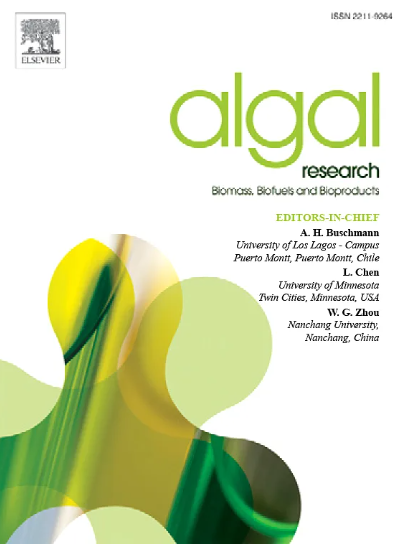生物素提高异养型佐宁青藻虾青素和总脂肪酸产量的多组学研究
IF 4.5
2区 生物学
Q1 BIOTECHNOLOGY & APPLIED MICROBIOLOGY
Algal Research-Biomass Biofuels and Bioproducts
Pub Date : 2025-06-18
DOI:10.1016/j.algal.2025.104158
引用次数: 0
摘要
虾青素是一种次生类胡萝卜素,主要在非生物胁迫下以牺牲细胞生长为代价积累。生物素作为羧化酶的重要辅助因子,已被证明能显著增强细胞的抗逆性。本研究探讨了在缺氮(ND)和高盐胁迫(HS)条件下,添加外源生物素对佐青绿染色体(Chromochloris zofingiensis)生长、虾青素和总脂肪酸(TFA)产量的影响。在两种胁迫下,外源生物素显著提高了生物量积累,降低了活性氧(ROS)水平。在浓度为1000 μg L−1的条件下,虾青素含量和干重均达到最大值,产量分别为对照的3.29倍和2.61倍。此外,生物素在ND和HS条件下可使TFA产量分别提高54%和36%。综合转录组学和代谢组学分析表明,ND下生物素显著富集与氨基酸代谢、脂质和碳水化合物代谢相关的途径;而HS下与能量代谢和类胡萝卜素生物合成相关的途径。生物素调节类胡萝卜素生物合成(PSY, PDS, ZDS, CrtZ)和脂肪酸生物合成(FabH, FabG)关键基因的表达,表明其在微调这些代谢途径中的作用。本研究确定了生物素在胁迫条件下作为虾青素和脂肪酸同时积累的有效调节剂。本文章由计算机程序翻译,如有差异,请以英文原文为准。

Multi-omics insights of biotin-enhanced astaxanthin and total fatty acid productivity in heterotrophic Chromochloris zofingiensis under stress conditions
Astaxanthin is a secondary carotenoid which predominantly accumulates under abiotic stresses at the expense of cell growth. Functioning as an essential cofactor for carboxylase enzymes, biotin has been demonstrated to significantly enhance cellular stress resistance. This study explores the effects of exogenous biotin supplementation on the growth, astaxanthin, and total fatty acid (TFA) production in Chromochloris zofingiensis under nitrogen deficiency (ND) and high salt stress (HS). Exogenous biotin significantly improved biomass accumulation with the reduced reactive oxygen species (ROS) level under both stresses. At a concentration of 1000 μg L−1, the maximal dry weight (DW) and astaxanthin content were achieved, which resulted in the highest astaxanthin yield as 3.29-fold and 2.61-fold of that in the respective controls under ND and HS conditions. Besides, biotin also enhanced TFA yield by 54 % and 36 % under ND and HS conditions, respectively. Integrated transcriptomic and metabolomic analyses demonstrated that biotin significantly enriched pathways related to amino acid metabolism, lipid, and carbohydrate metabolism under ND; whereas pathways associated with energy metabolism and carotenoid biosynthesis under HS. Biotin modulated the expression of key genes in carotenoid biosynthesis (PSY, PDS, ZDS, CrtZ) and fatty acid biosynthesis (FabH, FabG), demonstrating its role in fine-tuning these metabolic pathways. This study establishes biotin as a potent regulator of simultaneous astaxanthin and fatty acid accumulation in C. zofingiensis under stress conditions.
求助全文
通过发布文献求助,成功后即可免费获取论文全文。
去求助
来源期刊

Algal Research-Biomass Biofuels and Bioproducts
BIOTECHNOLOGY & APPLIED MICROBIOLOGY-
CiteScore
9.40
自引率
7.80%
发文量
332
期刊介绍:
Algal Research is an international phycology journal covering all areas of emerging technologies in algae biology, biomass production, cultivation, harvesting, extraction, bioproducts, biorefinery, engineering, and econometrics. Algae is defined to include cyanobacteria, microalgae, and protists and symbionts of interest in biotechnology. The journal publishes original research and reviews for the following scope: algal biology, including but not exclusive to: phylogeny, biodiversity, molecular traits, metabolic regulation, and genetic engineering, algal cultivation, e.g. phototrophic systems, heterotrophic systems, and mixotrophic systems, algal harvesting and extraction systems, biotechnology to convert algal biomass and components into biofuels and bioproducts, e.g., nutraceuticals, pharmaceuticals, animal feed, plastics, etc. algal products and their economic assessment
 求助内容:
求助内容: 应助结果提醒方式:
应助结果提醒方式:


